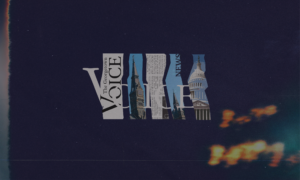What if I told you that the cardboard box sitting in the trash room of your dorm is a piece of art? Modern art aficionados might be impressed with its artistic flair and the provocative stance the piece takes on human consciousness. But what if, for you, it’s just a box?
For the less avant-garde, modern art can be intimidating. To appreciate how its purity of expression produces art that is free from stylistic limitations, you need to let go of the idea that it is “supposed to” mean anything at all.
When I first went to the Mark Rothko exhibit currently on display at the National Gallery of Art’s East Building, all I saw were a series of huge canvases lacquered in dark paint. Since all the canvases look almost exactly the same—all are large, dark squares—few visitors to the Gallery put in the effort to ride the elevator up to the Gallery. Those who successfully make it there usually only stay for as long as it takes them to decide that they are looking at “modern crap” and leave.
I once sat by myself in the Tower, as the exhibit is called, for two hours, observing the people and their reactions to Rothko’s seemingly bland collection. Everyone was confused, and honestly, so was I. I saw many people asking themselves, “Do these blocks of paint have any meaning at all?”
The truth is that modern art requires its viewers to decide what its abstractions mean to them. Visitors who desperately try to divine a piece of modern art’s objective meaning will find a trip to the Tower to be a painful experience. Unable to understand it, people often unfairly think of modern art as a movement that forces expression onto formless canvases.
But I find it refreshing. Unlike math or science, art requires no formal explanation, and the viewer is free to imagine and derive meaning in his or her own way. Academics have debated whether the goal of art is to convey emotion or master a technique. Art’s purpose, though, isn’t technical. In a world where the stress of getting through the day hampers our ability to be individual, I believe that art is the only space we have left for truly free expression.
Throughout history, people who see art as formulaic have caged its potential. Introductory Art History courses segregate works of art into “-isms” depending on their chronological and stylistic elements. While modern artists strive to escape stringent stylistic forms, academics relegate modern art itself to a system of rules that it sought to avoid.
Luckily, we have come a long way. From the 17th century French school of art, with its extremely rigid rules for creativity, to today’s urban graffiti and street art scene, society has come to appreciate a greater variety of modes of expression. As for the Renaissance-era artists who only lauded painstakingly crafted portraits of royal or Biblical figures, I am unimpressed by their picture-perfect portraits and chiaroscuro. Museum goers who see modern art and think, “Oh, I could have done this when I was three years old,” may be intrigued by the use of light and perspective in those works, but I certainly am not. Where is the passion?
Modern art can be interpreted as silly, random, and meaningless, but you can also interpret art as an expression of the world’s most pressing problems through seemingly haphazard layers of black and brown paint on a square canvas. Art doesn’t have to be complicated. It is whatever you want it to be, and it gives you the ultimate freedom—seeing what you want.
So if you’re willing to step out of your classical shell and enjoy D.C.’s vibrant contemporary art scene, I suggest you go check out the National Gallery of Art. Take it all in. Get a feel for both the traditional paintings in the West Building and their more abstract counterparts at the Tower. But please give a Rothko masterpiece at least 15 minutes of your time. In the end, what you see and feel is your experience, but if it is anything like mine, you will never mock his work as third-grade-caliber again.
Ultimately, modern art loses its universal voice when critics bury it with sophisticated and lofty rhetoric. So cut the disparaging jargon, and let the art speak for itself.
Modern art: Refreshingly abstract
November 12, 2010






ROBERTR Splashy Art Artist
Art online from artist designer Robert Rodriguez
http://www.splashyartist.com
Contemporary art for home & office modern abstract paintings
Modern Home/Office Original Art Paintings Direct from the Artist Studio.
Beautiful original paintings for you.
mordern art, abstract painting, Contempory art & painting buy here.